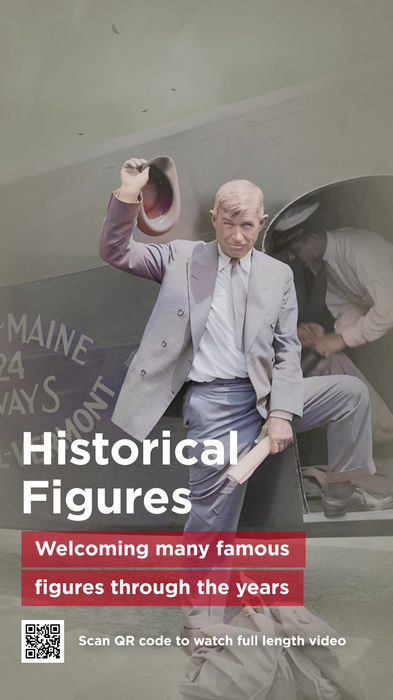
CLIENT
Massport
LOGAN AIRPORT
LOGAN100
Leveraging the rich century-long history of the airport, we created an immersive wall of content that functions both as an ambient intrigue and reacts to users' presence, providing a wealth of content to enjoy in place or take with them on their devices into the terminal while they wait.
Our Solution
An airport is a crowded bustling space, where some patrons have moments to spend, and some have hours. An installation needed to work equally as an ambient accent and as an engaging focal point with content accessible to both the passerby and the lingerer.
Insight
On the eve of the Boston Logan’s centennial, Massport wanted to elevate the traveler’s experience through the airport’s new international terminal to create a statement piece to accent their fresh modern visage.
Challenge

When such a user approaches, they are greeted with a trailer for one of seven short video documentaries created as part of this experience to educate and entertain the curious traveler about the lineage of this historic transportation hub.

It consists of an artistic array of displays upon which a wealth of animated imagery from the century-long history of the airport is presented to the passersby, cultivating an ambiance while enticing them to approach and learn more.


The “Logan 100” installation is an interactive digital history experience that we created for the confluence of Boston Logan Airport's centennial and the opening of their revamped International Terminal.
Overview
A 24-foot-wide collage of interconnected screens was therefore settled upon as the format with which to illustrate the airport's rich history in a mosaic of imagery and video, from there we embarked upon the design of the screen array and the surround.

On top of that, it was required to be simple and stable enough to run without issue for many years, so while more elaborate technological integrations (such as Augmented Reality or mobile app integration) were considered, ultimately, a simpler approach won out.

Given the nature of the location and the amount of foot traffic, the installation needed to impress at a glance, complement the space, and provide a compelling passive as well as active experience.
Ideation

We then took this imagery and created a suite of slow-moving collages for the ambient secondary screens, and keynote teaser videos to encourage the users to investigate further and discover the deeper content as they wandered past.
Provided with a wealth of historical imagery thanks to a generous partnership with The Boston Globe, we established a visual language which blended the warm sepia tones of the vintage imagery with hand tinting, combined with accents of ambient animation and careful layered transitions.
UX & Design
_gif.gif)

Inspired by the vast photographic library provided by The Boston Globe, we took an aircraft from the earliest days of the airport and combined it with a modern jetliner, swooping around the “Logan 100” text to embody the continuity from the earliest days of commercial flight on into the future.
The creative work for “Logan 100” extended beyond the screens, and one of the most significant, prolonged, and enjoyable challenges was to create a logo mark for the centennial event itself, something to symbolize the century-long history of Logan Airport in a single image.
Branding
UX & Design
We pride ourselves on choosing the right technology for the job, and while each asset was still hand-picked, and each of the dozens of videos painstakingly assembled by our team, AI was a boon in handling some of the image processing busywork.
Given the scope of this task and breadth of assets, it marked one of the first times we’ve used AI to augment and expedite the creative process, aiding the colorization and animation of hundreds of monochrome photographs.
Past & Future
UX & Design

In order to achieve coordination and continuity between the many screens involved in the project, as is typically the case with our work we wrote our own software.
With simplicity and longevity being the order of the day, careful attention had to be paid to asset loading and juggling, secure local networking, and even monitoring memory usage to ensure that the project can run for years on end without human intervention.

Development

The solution we decided upon was a technique of presence detection whereby the the user's proximity to the displays would trigger a change, rousing the installation from its ambient state to prompt the user to watch the documentaries.
In the shadow of the COVID-19 pandemic, a key challenge for this project was determining a method by which travelers could interact with the installation that avoided the need for physical touch.
Touchless Interaction
Development
From the opening ceremony to the day-to-day, with over 70 million travelers passing through Terminal E each year, the audience for “Logan 100” is likely the largest for any Showroom project to date, and we’re proud to be able to share these pieces of our hometown’s history with all who pass through Logan.
Reception



























